A sedentary lifestyle, a constant presence next to a computer, and a lack of physical activity are becoming more common. All of these and many other factors naturally affect the human body, leading to many changes or diseases.
One of these diseases is osteochondrosis. Let’s try to figure out what chest osteochondrosis is, what types it is and how to treat it.
What is osteochondrosis?

Osteochondrosisis a disease that affects the intervertebral discs and other tissues in the spine. Simply put, the vertebrae compress, thereby compressing the intervertebral discs.
IMPORTANT! If treatment is not maintained in time, the vertebrae become less flexible and begin to squeeze the nerve endings in the spinal cord. At this stage, swelling and severe pain appear.
There are four types of osteochondrosis, each named after the problematic part of the spine:
- neck;
- lumbar;
- chest;
- collaboration.
Patients often do not know which specialist to turn to for osteochondrosis. It should be noted that thetherapist refers the patient to a neurologist to clarify the diagnosis. If the case is severe, you may need the help of a vertebrologist, a narrow specialist in the field of spinal diseases.
Chest spine osteochondrosis or chest chondrosis
Osteochondrosis of the thoracic region (or simply chondrosis) of the spine is a degenerative-dystrophic disease caused by changes in the intervertebral plates of the thoracic vertebrae.
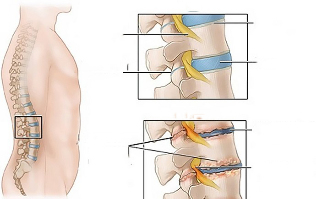
If we look in more detail, chest osteochondrosis first affects the bone tissue (vertebrae) and begins to affect cartilage tissue as it develops. After that, osteochondrosis can lead not only to severe pain, but also to other diseases and sometimes disability.
Let’s look at how patients with osteochondrosis of the chest are diagnosed. The majority of patients have clear signs of the disease. In the advanced stages, the person skilled in the art can determine the exact disease by a simple examination. In other cases, an X-ray or MRI is needed to take a complete picture.
Extent of osteochondrosis of the thoracic region
It is important to say that there is no exact degree of transition from degree to degree, it all depends solely on the individual characteristics of the human body.
There are four stages of chest osteochondrosis that progress gradually:
- 1 degree. Chest osteochondrosis is the very beginning when the patient feels almost nothing. There is no severe or lasting pain, and sometimes no discomfort. Such feelings occur only after severe overload or physical exertion, but most often the disease cannot manifest at all.
- Grade 2.The second stage is accompanied by the destruction of cartilage tissue, resulting in a reduction in intervertebral fissures and constriction of nerve endings, lymphatics, and even arteries.
- Grade 3.At this stage, fixed changes in the spine begin. Fixed means irreversible. For example, scoliosis, kyphosis, hump, and others develop.
- Grade 4.This is the last and most serious stage of the disease, with very serious consequences. At this stage, the consequences are almost irreversible because the changes in the spine become very severe.
Causes of chest osteochondrosis
Let's look at the list of causes (predisposing factors) of the disease:
- abnormalities in the intervertebral discs;
- intervertebral hernia;
- impaired blood supply to the spinal cord;
- lack of nutrients in the body (such as calcium);
- severe spinal cord injuries;
- weight lifting or regular high load on the spine;
- in a constant awkward and unnatural situation in the absence of exercise or any physical activity (sedentary lifestyle);
- curvature of the spine.
Symptoms and Signs of Chest Osteochondrosis
Any disease has its own symptoms and characteristic manifestations of pathology. Osteochondrosis is no exception, although when it comes to chest disease, the symptoms are often confused with heart disease or lung disease.
Consider a list of the main symptoms of chest chondrosis:
- Chest pain or burns.The main distinguishing feature of a given type of disease is chest pain, which occurs after severe physical exertion, bending to the side, severe hypothermia, or when the patient is in a situation (such as in a dream) for a long time.
- Pain between the shoulder blades.Exacerbation of pain involves raising the arms upwards and bending the sides strongly.
- Dull painsthat occur during deep breathing and exhalation.
- Cough.Cough does not occur immediately and often when this symptom appears, patients begin treatment with antiviral medications, which is a big mistake.
- Discomfort when walking between ribs. The symptom can appear even in the early stages of the disease.
- Shortness of breath.It becomes more difficult for a person to breathe during an effort.
- Night sweats.At night, a person is in a situation for a long time, which causes not only pain but also sweating.
- Numbness of hands at night.Extremes can numb, the symptom appears in the second stage of the disease when the vertebrae clamp the nerve endings and some blood vessels.
- Temperature.It does not always appear and is most often accompanied by severe pain.
- Intervertebral neuralgia. The patient feels stiffness and tightness, as if an invisible corset is being pinched in the chest area.
- High blood pressure.
- Panic attacks.Panic attacks typical of advanced cases (stages 3 and 4).
- Esophageal pain.
- Disruption of the gastrointestinal tract.Chest region and cardiac osteochondrosis.
Chest region and cardiac osteochondrosis
Heart pain or extrasystoles are often caused by osteochondrosis of the chest region. The pains are either prolonged (1-2 weeks) or severe and wavy. Often the heartbeat is fast along with the latter.
Patients often turn to cardiologists by mistake. But the study reveals that this is just another side effect of the disease, so "heart" pills and do not bring the desired result.
Osteochondrosis during pregnancy and lactation in women
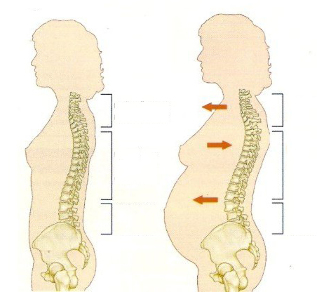
Chestrosis of the chest region often occurs during pregnancy or lactation. Most often, it all begins during pregnancy, when a woman experiences intense physical exertion. All of this, along with pregnancy, can lead to curvature in the chest or lumbar regions.
During breastfeeding, the situation often gets worse because often mothers are in a bad position for a long time when they are feeding a baby, carrying them in their arms for too long, or “rocking” them. Nevertheless, throughout the period, virtually no one was able to start the disease beyond Grade 2.
VSD in osteochondrosis
Osteochondrosis is the cause of vegetative-vascular dystonia. Experts say VSD is not a stand-alone disease, but it is always another problem that can have serious consequences overall.
VSD in this case may appear with poor posture during sleep, lack of physical activity and sedentary lifestyle, overweight, etc. As a result of two diseases, the patient's blood pressure starts to rise, insomnia, numbness of the hands, memory impairment and much more.
Osteochondrosis and scoliosis
scoliosisis a congenital or acquired lateral curvature of the spine. When we talk about congenital scoliosis, everything is clear. The acquired in this case is interesting because it most often appears for a reason.
Osteochondrosis of the thoracic spine can often be caused by scoliosis, although the cause may be different. Scoliosis can develop in the third stage of the disease.
Spiky chondrosis
"Spikes" are spinal osteophytes that are growths of bone tissue along joint processes or vertebrae. They are called thorns because they are often like thorns that grow out of the spine during x-rays.
This disease may be the cause of advanced osteochondrosis. It is a natural reaction of the body that tends to increase the area of the vertebrae so that the displacement does not cause so much pressure. It is mostly the "thorns" that cause the cartilage tissue to harden.
Typical manifestations of chest osteochondrosis in women
The female body is different from the male in many ways, so this disease has many features. In women, a number of vegetative nerve fibers pass through the chest region, reaching the limbs and internal organs.
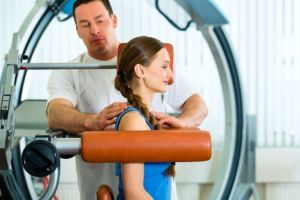
In women, chondrosis has a number of additional symptoms that patients often confuse.
This includes:
- heartache;
- stomach pains;
- pain in the liver;
- pain in the mammary glands;
- Feeling numbness or coldness in hands and feet.
Exacerbation of thoracic osteochondrosis
Exacerbation most often occurs in spring and fall, when weather conditions change dramatically, the body lacks essential vitamins, and human activity increases.
Exacerbation of chest osteochondrosis can be divided into two types:
- Dorsago.Sudden sharp pain that occurs in an uncomfortable situation after a long stay. There is a feeling that a dagger has been pushed into the patient between the shoulder blades, which is very similar to the symptom of a myocardial infarction. We recommend that you seek the assistance of a hospital specialist.
- Dorsalgia.Appears gradually and lasts for 2-3 weeks. The pain becomes quite strong and persistent, intensifying with bending, deep breathing, or prolonged staying in one position. Exercise and medication go through gradually.
Aggravation is a strong painful sensation that occurs not only when you are in a position or under heavy load for a long time, but simply for no reason. The pain can radiate to different parts of the sternum.
What to do in case of an acute pain attack?
Such attacks are most common in people who have already consulted a doctor, have orthopedic mattresses, corsets and know what a physiotherapy practice is. Those who are unaware of their illness often call an ambulance, which is also a good option.
However, here are some tips:
- Lie down and try to give your body maximum rest. When a person is lying, the stress on the vertebrae is minimal. It is best to lie on your back or in a fetal position.
- Take painkillers if the pain is unbearable.Also consult your doctor for recommendations.
- Try to lie down as much as possible in the first few daysuntil the pain subsides.
- As soon as the pain subsides, you need to start getting up more often and exercise.
How to reduce pressure with chest chondrosis at home?
It has already been said that high blood pressure is a symptom and a side effect of the disease in question.
If high blood pressure is caused by osteochondrosis, you can reduce the pressure as follows:
- Normalizes the blood supply to the brain.There are medications for this that need to be taken regularly on the advice of a doctor.
- Relieves muscle cramps.Regular exercise as well as massages and physiotherapy can cope with this.
- Removal of tissue edema.Physiotherapy, massages and acupuncture are also very effective here.
How and how to treat chest osteochondrosis?
The treatment of the disease in question usually takes a long time and involves a number of procedures. Some can be done alone at home, while others can only be done by professionals. Consider different treatments.
Treatment of osteochondrosis of the home at home
Basic Home Treatments:
- physiotherapy exercises or at least simple exercises in the morning;
- special mattress;
- simple self-massage techniques;
- herbal baths and rubs to relieve pain and restore blood circulation.
Medications and Medications
It is important to note that pain relief and healing are two different things. You should not constantly tolerate and use painkillers, you should take medications.
WARNING! It is very important to understand that osteochondrosis is a serious disease, so after a full diagnosis, tablets should be taken strictly on the recommendation of a specialist!
See a list of the most popular drugs:
- Analgesic.To be taken in case of aggravation.
- Hydroprotectors(restore cartilage tissue).
- Injections and injections.It is most often prescribed on the recommendation of a doctor, depending on the extent of the disease and the patient's propensity for certain medications.
- Ointments and gels.
- Vitamin complexes. All vitamin complexes are suitable, it is important that they contain B vitamins.
Massage and manual therapy
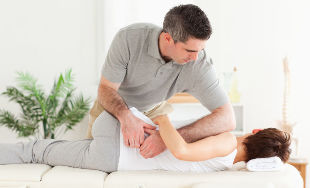
Massages are recommended for all types of osteochondrosis because they help relieve tension, pain, and restore the nervous system and circulatory system. But it is important to understand that massage must be therapeutic.
hand therapyis a procedure that is very similar to massage but uses slightly different techniques. Manual therapy has an effect on the anatomical structures of the human body with the hands of a specialist, eliminating limitations and relaxing muscles.
The peculiarity of hand massage is that it can be performed in different positions (lying on your back, not on your side, standing or sitting). Often during squeezing, bending, stretching, or other techniques, the patient may feel pain, but lightness and "freedom" can always be felt after the procedure.
Acupuncture
Acupuncture is not available to everyone, but it is still quite effective. The procedure helps to get rid of the inconveniences and also starts the recovery processes.
Acupuncture can be an important treatment tool in the early stages, eliminating the need for medication or other procedures to treat breast osteochondrosis.
Physiotherapy methods
Electrotherapy, magnetotherapy, laser therapy, shock wave therapy, balneotherapy, and vibration method are often used.
It is important to note that these procedures have a number of contraindications, so consult a professional.
Physiotherapy and exercise
The main task of physiotherapy exercises for thoracic osteochondrosis is to strengthen the back muscles, the muscles of the shoulder complex, and the respiratory muscles. Movement therapy should be practiced in special groups, but we can also do exercises at home. It is very important that you choose practice for a particular illness and not practice during exacerbations.
Let's look at some basic practices:
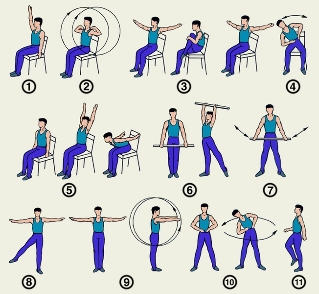
- While sitting on a chair, rest your upper back on your back and bend your hands as much as possible behind your head(it is important that the chest region works). Thereafter, maximum deflection occurs. Repeat 4-5 times.
- Also, take a deep breath while sitting on a chair and placing your hands behind your head, then lean back 3-5 times, leaning on your back. Then repeat the pre-bending and exhale slowly 4-6 times.
- Bend your chest region as much as possible while lying on your stomach(but not sharply), try to raise your head and legs as high as possible. Repeat 5-8 times.
- Standing with folded hands and legs.Raise your arm at the entrance, then lean back. Once the arms have been lowered as you exhale and tilted forward, you should try to round your back.
There are a number of simple back exercises that can help treat illnesses and are great for prevention or morning exercises.
Most exercises are simple and come from hands-on therapy or yoga:
- Effective exercise with a stick. A simple set of exercises to strengthen your back muscles and straighten your spine. The complex contains 5 basic exercises that need to be done daily.
- Exercises for chest osteochondrosis with prominence. In this case, it is recommended to perform the simplest practice therapy exercises, which include back bends in a standing, lying, and sitting position.
- Isometric exercises.
Isothermal exercises are rarely used, so let's look at some examples:
- "Karate" practice.When sitting or standing, the arms are bent at a 90-degree angle to the elbows, the fingers are clenched into a fist, the back is straight, looking ahead. Alternately, each hand taps in front of you.
- "Ballerina" practice. Sitting in a chair, the hands are closed at shoulder height at the front. Turns to the right and left are performed alternately at maximum (not sharp). If pain occurs during exercise, it should be stopped.
- Japanese Welcome Practice. The hands are folded to chest height, between palms and palms. Apply pressure with both hands for 30 seconds. Then you need a door. Put your hands on the edge of the opening and hold them. You don’t have to push your hand anywhere, you just have to stick to bend your hand (as if you want to go through the opening) forwards and then backwards.
Authoring methods in gymnastics help reduce the onset of severe symptoms:
- Alexandra Bonina 7 Basic Exercisesfor Chest Chondrosis.
- Bubnovsky's authoring method.This is a comprehensive treatment for osteochondrosis using special gymnastics as well as special custom simulators. According to the creator, the disease can be cured without cure with this method.
- Gymnastics from Dr. Popov's cervicothoracal chondrosis.The main difference of gymnastics is that it does not strengthen the big muscles (like most other exercises), but on the contrary, the small ones. This type of gymnastics is also called micro-gymnastics.
- Exercises according to Dr. Shishonin's method.This method consists of 7 simple but unique exercises that strengthen the muscles of the spine as well as the chest.
Treatment with folk remedies
Consider the most popular and effective folk remedies: herbal baths, marigold and dandelion-based rubbing, chamomile tincture, and lemongrass leaf and orange peel tincture. Various abrasions are often used in folk medicine.
Ficus tincture with butter:
- Cut up a few ficus leaves and mix with butter in a 1: 1 ratio.
- Then place the mixture in a warm oven for 1. 5 hours, then remove and filter.
- The cooled material should be rubbed along the spine daily.

Potato compresses will also be effective in treating osteochondrosis of the chest:
- Take 4-5 potatoes and bring to a boil, then crush and form a thick puree.
- This puree is wrapped in several layers of the stamp and applied to the affected area of the spine.
- The compress is then covered with a woolen scarf or thick towel until it cools.
- When the potatoes have cooled, remove the compress and rub the sore spot with alcohol, then lie under the blanket. Repeat every other day before bed until the pain goes away.
Prevention of chest osteochondrosis
Prevention of chest osteochondrosis is an active lifestyle without excessive stress. Adequate nutrition, intake of vitamin and mineral complexes, and regular medical check-ups.
However, if we deviate from the general rules, we can distinguish several features:
- He sleeps on an orthopedic mattress in a natural position.
- When sitting, keep your back straight, stand up regularly and warm up.
- Morning gymnastics, gym, yoga and the like.
Such activities have a positive effect on the spine and the body as a whole, so regular moderate physical activity helps prevent spinal diseases.
In summary, suppose osteochondrosis is a serious disease that must be treated without failure. Self-healing is not recommended, especially if the pain becomes a constant companion. But it is also worth remembering that the best treatment is prevention, so a healthy lifestyle is the key to success and good health!



































